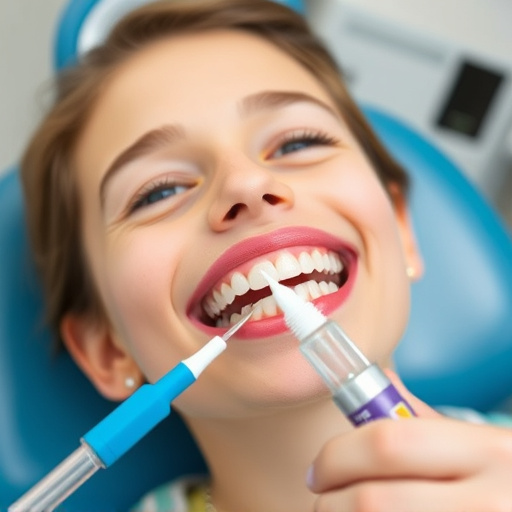Dental Bridge Replacement: Enhancing Aesthetics and Longevity
Dental bridge replacement offers both functional and cosmetic benefits, securely replacing missing t…….
Dental bridges have emerged as a transformative solution in dentistry, offering a permanent alternative to dentures for missing teeth. This article delves into the comprehensive world of dental bridge replacement, exploring its historical evolution, global impact, technological advancements, and the challenges it faces. By examining these aspects, we aim to provide an insightful guide for both dental professionals and individuals considering this procedure. The journey ahead reveals a dynamic landscape where innovation meets oral health care, ultimately shaping the future of restorative dentistry.
Dental bridge replacement is a surgical procedure designed to fill gaps left by missing teeth, providing a natural-looking and functional solution. A dental bridge consists of an artificial tooth (or teeth) known as a pontic, supported by abutments attached to adjacent natural teeth or implants. The key components include:
The concept of dental bridges dates back centuries, with early attempts recorded in ancient civilizations. However, modern dental bridge replacement gained traction in the 20th century with advancements in materials and surgical techniques. Here’s a brief timeline:
| Era | Advancements | Significance |
|---|---|---|
| Late 1800s – Early 1900s | Gold and porcelain bridges became prevalent. | Introduced durable and aesthetically pleasing options, setting the foundation for modern bridges. |
| Mid-20th Century | Development of acrylic resins and composite materials. | Enhanced the flexibility and cost-effectiveness of bridge construction while maintaining strength. |
| Late 20th Century | Introduction of dental implants as an alternative support system. | Offered a more secure and long-lasting solution, revolutionizing oral restoration. |
| 21st Century | Technological advancements in design software and 3D printing. | Improved precision, patient comfort, and customization, allowing for more natural-looking bridges. |
Dental bridge replacement offers numerous advantages:
Dental bridge replacement has gained worldwide acceptance, with varying adoption rates across regions:
Key trends shaping global bridge replacement include:
An international collaboration between dental clinics in the US, Europe, and Asia led to the development of a standardized bridge protocol. By sharing best practices and design principles, they created a globally accepted model for successful bridge replacement, ensuring consistency and improved outcomes across borders.
The global dental bridges market exhibits notable dynamics:
Investment in dental bridge technology follows several trends:
Economic factors play a crucial role in making dental bridges accessible:
Technological breakthroughs have significantly enhanced dental bridge replacement:
Advancements in materials science have led to:
Upcoming technologies poised to shape dental bridges include:
Dental bridge replacement is subject to stringent regulations worldwide:
Dentists performing bridge replacements must adhere to strict licensing requirements:
Insurance plays a pivotal role in patient access:
Despite its benefits, dental bridge replacement faces several challenges:
Criticisms of dental bridges include:
Patient Profile: A 45-year-old patient from Tokyo, Japan, presented with missing molars due to decay and periodontitis.
Treatment Approach: The dentist designed and crafted a fixed bridge using advanced CAD/CAM technology, ensuring an exact fit and aesthetic harmony with the adjacent teeth.
Outcomes: The patient achieved improved chewing function, enhanced smile aesthetics, and better overall oral health. Follow-up visits revealed excellent gum health and no signs of complications.
Scenario: A 60-year-old patient from Toronto, Canada, had significant bone loss around a missing premolar, making traditional bridge placement challenging.
Solution: The dentist recommended an implant-supported bridge after evaluating the patient’s oral health and bone density. By using advanced bone grafting techniques and implants with a unique design, they successfully restored the patient’s chewing ability and esthetics.
Patient Testimonial: “The entire process was transformative. I can chew like never before, and my smile looks natural. It’s amazing what modern dentistry can achieve.”
The future of dental bridge replacement holds immense potential:
Market projections indicate:
Dental bridge replacement has evolved from a conventional treatment option to a highly sophisticated procedure, offering individuals the opportunity to regain their confidence and oral health. With technological advancements, improved materials, and global collaboration, the future of this field looks promising. As we continue to explore innovative solutions and address challenges, dental bridges will remain an essential component of modern dentistry, enhancing the quality of life for countless individuals worldwide.
Q: How long do dental bridges typically last?
A: With proper care, dental bridges can last for 10-25 years or more. Regular dental check-ups and cleaning are crucial to ensure their longevity.
Q: Are there any alternatives to traditional dental bridges?
A: Yes, alternatives include dentures and dental implants. Dentures require less surgery but may not be as stable, while implants offer a fixed solution with improved aesthetics and function.
Q: Can anyone get a dental bridge?
A: Eligibility depends on oral health, bone density, and overall health. A comprehensive assessment by a dentist is essential to determine suitability.
Q: How do I choose the right dental bridge material?
A: Material selection depends on aesthetic preferences, budget, and mouth functionality. Ceramic and zirconia bridges offer excellent aesthetics and durability, while metal alloys provide strength and cost-effectiveness.
Q: Are there any new technologies in dental bridge replacement?
A: Absolutely! Digital imaging, CAD/CAM technology, 3D printing, and AI are shaping the future of bridges, allowing for more precise, personalized, and efficient treatment.

Dental bridge replacement offers both functional and cosmetic benefits, securely replacing missing t…….

Dental bridge replacement is a transformative procedure that restores smiles and oral health by fill…….